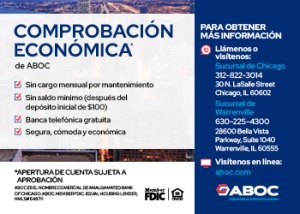Latest
-

-

-
 Mexico Fest at Navy Pier May 1, 2025
Mexico Fest at Navy Pier May 1, 2025 -

-

Popular
Tags
Artistas Adolescentes Aprenden el Valor de un Arduo Trabajo
Artists Nationwide
Brazilian Students Tour Kirie Water Reclamation Plant
Challenges of Returning to School in Adulthood
Chicago
Chicago Air and Water Show
Chicago CPS
Chicago Dream Act
Comparta su Historia
CPS
Cultura Latina
Delicious Salad Meals
Dream Act
Dream Act chicago
Dream Relief
Dream Relief Chicago
El Alma de la Fiesta
Ending Summer on the Right Foot
Ensaladas sencillas y deliciosas como plato principal
Estudiantes Brasileños Recorren la Planta de Reclamación de Agua Kirie
Feria de Regreso a la Escuela de la Rep. Berrios
Festival Unísono en Pilsen
Grant Park Spirit of Music Garden
ICIRR
ICIRR Receives Criticism Over Dream Relief Day
ICIRR Recibe Críticas
Jose Cuervo Tradicional
José Cuervo
José Cuervo Tradicional Celebra la Cultura Latina e Inspira Artistas a Nivel Nacional
Latin Culture
Los Retos de Volver a la Escuela Cuando Adultos
Meijer Abre sus Puertas en el Distrito de Berwyn
Meijer Opens in Berwyn District
orth side Summer Fest on Lincoln Ave
PepsiCo Foundation Apoya Futuros Periodistas Hispanos
PepsiCo Foundation Supports Future Hispanic Journalists
Share Your Story
Show Acuático y Aéreo
Simple
StoryCorps
storycorps.org
Teen Artists Learn the Value of Hard Work
Terminando el Verano con el Pie Derecho
Unisono Festival in Pilsen
‘El Chente’






Revisiting the Bracero Program
By: Daniel Nardini
Fast-forward to 2012, and strangely enough America faces a manpower shortage in regards to having enough people to pick certain kinds of fruit and vegetables that still require those skilled in picking the fruit and vegetables when they are ripe. There may be many Americans who can pick fruits and vegetables and endure long hours in the sun and foul weather, but most Americans cannot and hence there remains a labor shortage in this part of the agricultural sector. Many farmers from across the country are crying out for the U.S. government to try and expedite the legal process of importing workers from Mexico or Central America to be able to have enough people to pick the fruit and vegetables we eat. But the immigration process, which is now totally overburdened with bringing in immigrants for a whole list of reasons, is too slow and antiquated to even begin to handle bringing in enough agricultural workers for America’s needs.
Hence, a new Bracero Program might be the answer. Under such a program the whole visa process could be expedited far quicker, and such an agreement between the United States and Mexico (and all other countries in Central America) could be mutually beneficial to both countries. The help in America’s agricultural sector would help to lower prices for the American consumer and also to increase the amount of fruits and vegetables in the market thus making America’s agricultural sector more productive. At the same time, the imported migrant workers could make money that they can send back to their respective countries and greatly improve the economic well-being of their own countries of origin. This type of program has worked before, and under the circumstances prevailing it could work again.